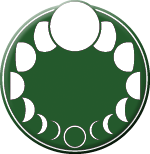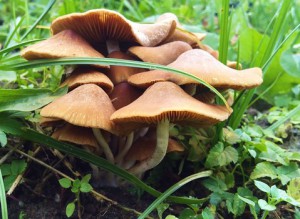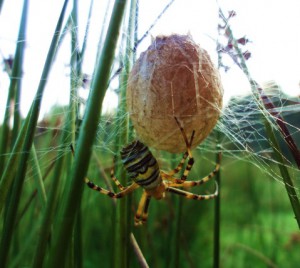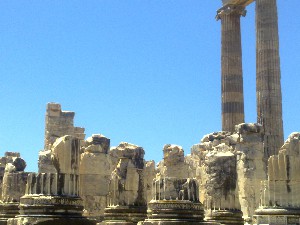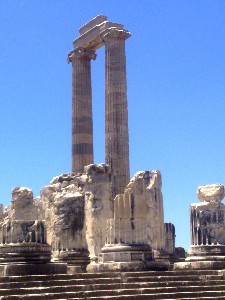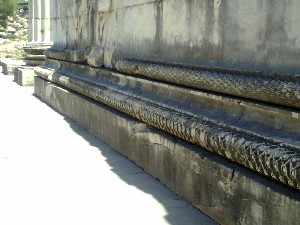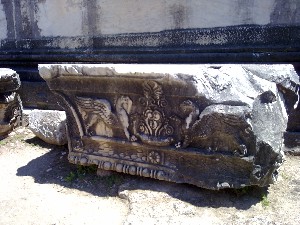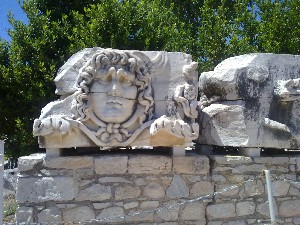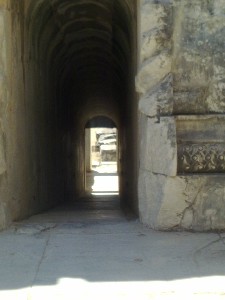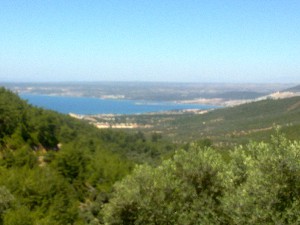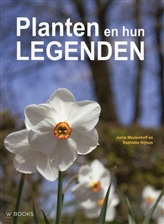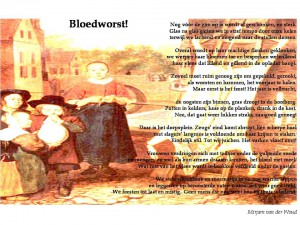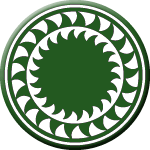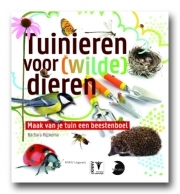
The Temple of Apollo, Didyma
(Morgana, June 2012)
This is an article about the magnificent Temple of Apollo at Didim / Didyma, Turkey. It is part of a series of articles to complement From Hekatesia to Aphrodisias and the journey I (Morgana) made in Turkey in June 2012.
I found this article in 2005 after my first visit to Bodrum and to my surprise it is still available on internet. It contains such good information I felt it was worth publishing it here, with the photographs I took when I went back this summer.
The connection with Apollo and Artemis is clear. Unfortunately although the Temple to Apollo has been restored and is open to the public, the Temple to Artemis isn’t. I asked if there were plans for further excavation but got no real answers.
David Meadows wrote in August 2010: Temple of Artemis at Didyma?
“The English version of this one has lost something in translation … it appears to suggest that there might be remains of a temple of Artemis at Didyma, which is something that has long been the subject of scholarly debate. We really need to get some decent English coverage of this.”
GERMAN archaeologists are looking at a new find which could suggest a second temple close to the Temple of Apollo. They have extended their excavations away from Apollon and have discovered a wall which they consider to be part of another temple – maybe that the Temple is for Artemis – the twin of Apollon.
Representative of Ministry of Culture and Tourism Ferhan Büyükyörük said: “An illegal dig was done in the area previously, which revealed the remains of a wall.
“The excavations team is searching this year to see if there is more to the wall and if it belongs to a structure. Its size and location suggests a building to the south of this wall. Didyma means twin; Apollon was the twin brother of Goddess Artemis.
“This wall might belong to an Artemis Temple. We will see what the excavations unearth.” The works will continue until September.
The original article ‘The Apollo Temple of Didyma’ can be found here: http://www.adiyamanli.org/didyma.html).
***
Also called DIDYMI, or BRANCHIDAE, ancient sanctuary and seat of an oracle of Apollo, located south of Miletus in modern Turkey. Before being plundered and burned by the Persians (c. 494 BC), the sanctuary was in the charge of the Branchids, a priestly caste named after Branchus, a favourite youth of Apollo. After Alexander the Great conquered Miletus (334), the oracle was re sanctified; the city administered the cult, annually electing a prophet. About 300 BC the Milesians began to build a new temple, intended to be the largest in the Greek world. The annual festival held there, the Didymeia, became Panhellenic in the beginning of the 2nd century BC. Excavations made between 1905 and 1930 revealed all of the uncompleted new temple and some carved pieces of the earlier temple and statues.

Apollo Temple: Morgana, June 2012
Made a township in 1991, Didyma is a peninsula surrounded by the provincial limits of Mugla and the Akbük cove in the east, the Aegean Sea in the south and west and the lake Bafa and the river Meander in the north. It is located 106 km from Aydin, 53 km from Söke, 73 km from Kusadasi, and 110 km from Bodrum. The number of its inhabitants is 10.400 according to the census of 1990, and its area 300 km2.

Apollo Temple, Morgana, June 2012
The Apollo temple of Didyma (the Didymaion), located within the boundaries of the village of Yeni Hisar in the Söke district of the province of Aydın, was known as a sanctuary and seat of an oracle attached to Miletus. Recent excavations revealed remains, which showed that Didyma was not only a seat of an oracle but also the site of dense settlement.
The research concerning the origins of the names of Didyma and Didymaion has been a subject of discussion going on for years. Along with several other myths, it was thought that the name Didymaion that meant ’twin temples’ or ’temple of the twins’, was related to Artemis, the twin sister of Apollo. However, as no definite evidence could be found, this theory also remained as a myth. With the intensification of work in recent years on the ‘Sacred Road’ connecting Miletus and Didyma, and the finding of the place of the Artemis cult during the excavations however, it was proved that this thesis was right. The two temples built for the twin brother and sister, the Artemision and the Didymaion, constitute the origin of the name Didyma.
Apollo and Artemis were closely related to the mother goddess Cybele who had, from prehistoric times, a very important place in Anatolia. The mother goddess Cybele had various names (such as Kubaba, Isis, Hepat, Lat) and epithets according to localities and cultures. The most widespread of these names was Dindymene which was derived from mount Dindymus and which is remarkable for its resemblance to the name Didyma.

An Apollo & Artemis monogram? The capital letters AA scratched into the wall leading down to the inner temple, Morgana, June 2012

The narrow passage leading to the inner temple. Along the walls the AA monogram was scratched numerous times. The ’twin’ Artemis Temple is not far from the Apollo Temple. However it is not open for visitors. (Morgana, June 2012)
The name of Apollo is considered not to be Greek. Apollo, who, because of the resemblance in names was identified with the god Apulunas mentioned in Hittite written sources, represented shape given by rational perception, temperate power, fine arts and light. Besides these, he was renowned for his ability to prophesy, and he communicated to people through mediums and oracles his knowledge of the future.
The dependence of communities on religion increased as it was seen that gods possessed forces to direct according to their will, all phenomena and events relating to nature and society. As a natural consequence of the increase in religion, belief in the power to prophesy of the gods who could foresee events and phenomena was intensified.
In the Archaic period the oracle of Apollo had great fame. The great number of temples erected in Anatolia as seats of oracles is evidence that belief in gods had reached enormous proportions. The most important of the temples dedicated to Apollo were the Temple of Apollo at Delphi in Greece, and the Didymaion in Anatolia. These two seats were in constant rivalry with each other. A fine example of this rivalry can be clearly seen in the following verses by the oracle of Delphi.
In the mid 7th century BC, in the oracles of Apollo, the god could be consulted once a year for official matters, and the answers received to questions directed would be in the form of “yes or “no”. When in later years, consulting the god also for private matters became a tradition, these consultations became gradually more frequent. The oracles of Apollo grew very rich as a result of this, and their fame and influence spread over large areas. They became as powerful as the state they were in and were effective in shaping the destinies of persons and communities, and particularly in politics where they played a very important role, they very often caused wrong decisions to be taken.
Pausanias states that the Apollo temple at Didyma had been built before the Greek colonization (10th century BC). It is believed in the light of this that the existence of Didyma, like that of Miletus and Priene goes back to the 2nd millennium BC. However according to the results of excavations and research work undertaken up to the present day, the earliest temple remains date back to the end of the 8th century BC.
One learns from Herodotus that valuable votive offerings were presented to the temple by King Necho of Egypt at the end of the 7th century BC, and King Croesus of Lydia in the 6th century BC.
It is believed that the construction of the Archaic temple was begun in the mid 6th century BC and was completed at the end of the same century. In the 6th century BC, the Didymaion was administered by a priestly caste named Branchids. During this period, which lasted about 100 years, the temple flourished and went through its most brilliant era.
It was completely burned and plundered by the Persians during the battle of Lade, the priests of the temple were driven to Susa, and the cult statue of Apollo was taken to Ecbatana. The statue of Apollo which was dated back to 500 BC, was made by the sculptor Kanachus of Sicyon and reflects Anatolian – Hittite characteristics.
The construction of the Hellenistic temple was begun after the victory of Alexander the Great over the Persians. However, it was understood from the remains that this Hellenistic temple was not completed.
The temple of which the construction was continued under Emperor Caligula (37 – 41 AD) who wanted to be though of as the god of the temple, and later under Hadrian (117 – 138 AD), was never completed. With the alterations made in the 3rd century AD to protect it from plunder, the temple took on the appearance of a fortress, and flourished under the reigns of Aurelian (270 – 275) and Diocletian (284 – 305).
There are findings which indicate that work was done on the temple during the reign of Emperor Julian (361 – 363).
In the beginning of the 5th century AD, Emperor Theodosius had a church built in the sacred courtyard (Adyton – Sekos). This church, which had the appearance of a three – winged basilica, was destroyed in an earthquake and later rebuilt with one wing (9th century AD).
In the 10th century AD, the two – columned hall (Chresmographeion – hall of the oracle) and the pronaos, which were used as storage areas, were greatly damaged in a fire, and most of the marble turned into lime.
After the Seljuks and the Mongols conquered the region the temple was completely abandoned.
An Italian traveller who visited Didyma in 1446 records that the whole temple was standing, however at the end of the 15th century the temple was completely destroyed by an earthquake and turned into a heap of marble. In later years the temple was used as a quarry, and many of its architectural elements were used as building material in the construction of dwellings and other buildings by the local people.

Temple of Apollo, Ionic pillar
The magnificent Ionic Capital, Morgana, June 2012
EXCAVATIONS
The first excavations in Didyma were made in 1858 by the English under the direction of Newton. The area excavated was the Sacred Road.
In the temple, excavations were first begun in 1872 by the French under O. Rayet and A. Thomas. The aim was to find the cult statue of Apollo, but at the end of the work which lasted two years, the cult statue had not been found. However, it had been possible to determine the dimensions of the temple and to reconstruct its plan.
In the excavations of 1895 – 96, again undertaken by the French, the work, supervised by B. Haussoullier and E. Pontremoli, was concentrated on the northern part of the temple. These excavations were stopped shortly after due to economic reasons. Excavations begun in 1905 for the museums in Berlin under the supervision of Th. Weigand, were continued on a systematic basis until the year 1937. During this time a great portion of the temple was revealed. After this date, excavations were interrupted and work on publication of the results was begun.
In order find solutions to certain problems concerning the temple and its surroundings, excavations were begun again in 1962, this time for the German Institute of Archaeology, under the supervision of R. Naumann. When R. Naumann left, the excavations in Didyma were continued under the supervision of Klaus Tuchelt. Work is at present still going on in the area with special attention to research on the Sacred Road.
THE SACRED ROAD
The Delphinion is accepted as the starting point of the Sacred Road connecting Miletus and Didyma. The road ran from the Sacred Gate of Miletus southwards in the direction of the coast to Panarmos Harbour (above Akköy), and – bending south – east from the port, reached the Didymaion. Within the boundaries of Yenihisar, the Sacred Road runs close along the side of the asphalt road. A portion of the Sacred Road has been revealed by excavations and exploratory trenches dug in recent years. However, due to certain bureaucratic obstacles, it has not yet been possible to establish its connection to the temple.
On either side of the road there were statues of Branchids (priests and priestesses attached to the temple), crouching lions and sphinxes, all of which gave the road an impressive appearance. Monumental tombs and sarcophagi belonging to important persons were also dispersed along the road. Statues of Branchids revealed in the excavations carried out by Newton in 1858 on the Sacred Road have been taken to the British Museum. Some fragments belonging to the statues are in the storeroom of the house of excavations in Didyma. Four of the Branchid statues in which Hittite influence is apparent and which have been dated back to the 6th century BC, are on display in the museum in Miletus. In the years 100 and 101 AD Emperor Trajan had the Sacred Road restored. The parts of the road that had fallen down were raised to a higher level and the other parts were repaired. Inscriptions indicate that the restoration work was completed in a very short time.
It was understood from a milestone revealed during excavations that the road was 16.5 kilometres long. According to the portions uncovered, the width of the road which was made of stone blocks, changed between 5 and 7 meters. On both sides of it were rows of shops, votive fountains, monumental tombs, baths, and the area for the cult of Artemis. Findings indicate a dense settlement. The group of people who set out from Miletus to join the annual celebrations and festivities which were held in the Didymaion every spring, reached the temple after a long walk, there were therefore, resting places on the Sacred Road. It is understood that the Terrace with the Sphinx, uncovered during excavations carried out in 1985 about 4 kilometres to the south of Akköy, was a halting place built for rest purposes.
THE ARCHAIC DIDYMAION (The Apollo Temple at Didyma)
Remains of foundations of the Late Geometric period were found during excavations carried out in 1962 by German archaeologists within the secos of the Hellenistic temple to look for the first Apollo temple of Didyma which, according to Pausanias, had existed before the 10th century BC. The temple which, according to the foundations of secos walls uncovered in the north and south parts, was 10.20 meters wide and 24 meters long and slightly narrowed towards the east, was built at the end of the 8th century BC. The small and simple temple contained a secos (sacred courtyard), an altar, a sacred source, a cult statue and the symbols of Apollo. The Late Geometric temple did not have a naiscos, the naiscos is understood to have been built at the end of the 7th century BC to protect the cult statue. Exploratory digging carried out to the south – west of the temple revealed the remains of a columned building 15.50 meters long and 3.60 meters wide. The remnants and ceramic findings have been dated back to the end of the 7th century BC.
Not many remains are left to the present day from the Archaic Didymaion, as it was burned, destroyed and plundered in 494 BC (the battle of Lade). Besides, findings relating to the Archaic temple are further limited by the fact that the Hellenistic temple was built over the foundations of the Archaic one. However, the construction of the plan was possible and various examples of reconstruction were made through ancient authors, as well as architectural and sculptural fragments found during borings and excavations.The Didymaion became really important in the first of the 6th century BC when all Ionian cities, and especially Miletus, reached their most flourishing era. The temple was rebuilt in 560 – 550 BC with larger proportions. The influence of the temples of Hera at Samos and Artemis at Ephesus are apparent in the Archaic Didymaion.
The temple, an 87.65 meter long and 40.89 meter wide building of a dipteral plan (having a double row of columns all around), rested on a two – stepped crepes. The longer sides had 21 columns each, the east had 8, and the west 9, whereas in the pronaos there were 8 columns in two rows. Together with the columns within the peristasis (the surrounding hall), the total number of columns added up to 112.
The parts of the temple which were not visible from the outside were made of local tufa, while those that were visible were made of marble. The marble was provided from marble quarries on the island of Toşoz, and in the hills above the village of Pınarcık near Bafa lake. One can still see fragments of roughly prepared column shafts in the quarries at Pınarcık. The party worked marble, brought from the quarry to Latmos Harbour, was then taken by sea to Panarmos Harbor, and from there it was carried to the temple
The bases and capitals of the 15.45 meter high columns bear the characteristics of the Artemis Temple at Ephesus; the bases consists of tori and double trochili, the Ionic capitals have large volutes, the column shafts have 36 flutes. On the eastern facade, the lower parts of the columns in the front row were decorated with reliefs; a head of a woman (Kore) from these relief is on display in the Charlottenburg Museum in Berlin. The characteristics of all these elements indicate that they were at the latest made in the year 550 BC, which coincides with the date of the initial construction of the Archaic Didymaion.

The python running along the temple walls? Morgana, June 2012 (see footnote 1)
The double row of columns in the pronaos indicate that it had a roof. The architrave is quite narrow. In the corners are high reliefs of winged gorgons and behind these are figures of crouching lions. It is believed that certain wild animals’ figures were also there besides the lions. This type of decorations is quite unusual in temple entablature. These pieces of work which can be dated back to the end of the 6th century BC, were probably made during restoration works which took place in the temple at the time. On the architrave rest, in due order, a band of egg – and – dart molding, dentils, another band of egg – and – dart moulding, a cornice and a roof.
The inner sides of the walls of the secos (sacred courtyard) were fortified by pilasters in the form of half – columns, which brought colour to the long, high walls. The height of the walls of the 50.25 meter long and 17.45 meter wide secos reached 17.5 meters. Walls of this height give the imprecision that the secos was roofed, but the greatness of the distances between the pilasters on the walls destroys this theory.
Within the secos stood the naiscos (little temple) where the cult statue of Apollo was kept. However, there are not many findings belonging to this buildings. During borings in the Hellenistic naiscos, foundation remains belonging to a smaller building were found. It is believed that these foundations belong to the Archaic naiscos. The bronze cult statue is known as the ‘Apollo Philesius’ and represents Apollo catching a deer.
In front of the temple (east) and on the same axis stands a circular altar. This altar, of which the other diameter measures 8 meters and the inner one 5.5 meters, had two doors. The holes for the hinges can still be seen on the thresholds. The altar of which the inside is very well preserved, had been used in the Archaic, and also in the Hellenistic and Roman temples as the sacred place where the animals presented as votive offerings were burned. The great amount of ashes found in the building during excavations is evidence of this. In ancient times, animals offered to the gods of the sky were burned in this type of altar, and sanctification was achieved by washing in the blood of the animals offered to the gods under the ground. To the north of the altar is the sacred source. The masonry of the lower parts of this circular well shows that it was constructed in the Archaic period.
3.5 meter high protective walls encircle the front part of the temple. These walls must have been built to diminish the difference of levels in the large area in front of the temple. In the uncovered portion of these protective walls were five outlets with staircases, each 2.5 meters wide. The central stairs are situated just opposite the altar, on the same axis. These stairs led to the terrace on which stood the votive and gods’ statues. The style of the egg – and – dart molding used to decorate the upper part of the terrace wall as well as the workmanship of the wall and stairs, bear the characteristics of the Archaic period.
On this terrace one also comes across the remains of two long structures built of limestone. The 34.5 meter long and 7 meter wide buildings must have been shops where visitors took shelter or shopped. These buildings also show the characteristics of the Archaic period.
Next to the stairs along the terrace wall situate in the direction of the south – east end of the temple are rows of benches. It is understood that these benches extending parallel to the steps of the temple were built in the Hellenistic period, and were the rows of benches for the stadium situated to the south of the temple, Every four years festivities called the “Megala Didymeia” and musical shows, were held here, and torch processions and competitions were arranged. The bases having a hole in the center, which marked the starting points of the races, can be seen at the eastern end of the stadium. These bases lie on the same axis as the altar.

Griffins and other fantastic beasts, Morgana, June 2012
THE HELLENISTIC DIDYMAION
What remains of the temple in the present day, through hundreds of years of earth – quakes, fire, destruction and plunder are mostly remnants of the Hellenistic period. The Roman characteristics witnessed in certain parts of the temple, are elements which have reached the present day from the temple, which continued to be built during the Roman period also.
It is known that the construction of the Hellenistic temple was begun in 313 BC, and that it was erected over the Archaic temple which was burned and destroyed in 494 BC. The donations of Alexander the Great and King Seleucus I of Syria were of great help in the rebuilding of the Didymaion. Furthermore, Seleucus I had the cult statue of Apollo brought back from Ecbatana (300 BC) and replaced in the temple.
The plan of the temple was made by Paionius of Ephesus and Daphnis of Miletus. These two renowned architects had also worked on the Artemision at Ephesus (one of the seven wonders of the world) and the Heraion at Samos, which were considered to be the largest and the most magnificent temples of the Hellenistic period. The Didymaion emerges as the third largest edifice of the Hellenistic period, following the former.
The plan, as a requisition of the cult, had to provide an open air space to hold the Sacred Fountain, the Altar, the Laurel Grove, considered to be the sacred tree of Apollo, and it had also to shelter the cult statue. All these elements had to be arranged in a way not to disturb the covered spaces. The architects constructed on ostentatious example of architecture, by the perfect use of the local characteristics of the cult of the oracle and of the spaces of different levels. This temple differed from a normal temple plan in that it was also the seat of an oracle. The edifice consisted of a long pronaos, a rectangular hall with two columns in the centre (the oracle hall-Cresmographeion), a sacred courtyard surrounded by high walls (Secos-Adyton), and in this courtyard a small temple sheltering the cult statue of Apollo (the naiscos), all set on the same axis but at different floor levels.
The temples, situated over the Archaic one and of larger proportions, had necessitated an uncommonly high lower structure. The temple rested on a 3.5 meter high and 7 – stepped platform (crepis), and had in the centre of the front facade a 14 – stepped stairway of which both sides were limited. The width of these stairs was equal to that of the temple. This characteristic is also visible in the Classical Artemision. The temple, 109.34 meters long and 51.13 meters wide, was built on a dipteral (having a double row of columns all around) plan. It had 21 columns each on its longer sides, and 10 each on the shorter ones. Together with the columns within the peristasis and the ones in the pronaos and cresmographeion, the total number of columns added up to 122. The cost of the columns of which only three stand today, was very high. Excavations have revealed a great number of inscriptions showing the calculation of construction costs prepared during the building of the temple. It is understood from these documents that the cost of one column was 40,000 drachmae and that the daily wages of a labourer was only 2 drachmea. This means that one labourer would have to work for 20,000 workdays to put a column in its place, or to adapt it to the present day, by assuming that the minimum daily wage of a stone workman be 10,000 TL, the construction cost of a column could be calculated to amount to 200 million TL. It is also known, from these inscriptions that, from 250 BC onwards, 8 architects and 20 construction companies worked for the temple.
Such a large and costly building could certainly not have been finished in a short time. It is understood that the construction went on in the 3rd and 2nd centuries BC, and that some of it was completed during the Roman period. Although a great portion of the columns were prepared and set in their places, it can be seen that those in the outer row of the peristasis and especially those in the rear facade were never completed.
The height of the columns was first determined in 1873 by A. Thomas as being 19.71 meters. The accuracy of the measurement was evidenced by recent research work also. The lower diameters of the columns vary between 1.96 and 2 meters. This conforms to the rule that, in the Ionic order lower diameters of columns are equal to 1/10th of their height.
A. von Gerkan has calculated the total height of the temple, including the 19.71 meter high columns, the stepped lower structure and the entablature, as 29.40 meters. This measurement gives an idea of the magnificence of the temple before it was destroyed.
The double row of columns round the temple gave the building a very impressive appearance as well as depth. Of the 108 columns in the peristasis (the peripheral hall) about 80 are standing in their original places. The letters seen in the upper and lower parts of the fragments of column shafts were written by the workmen to avoid any mistakes during the placing of the columns in their places. This is also an indication that the columns had entasis (a swelling of column shafts).
Of the three Hellenistic columns still standing, the workmanship of two are complete and they carry the entablature. The third column, which carries a capital, has no fluting in its shaft. According to the characteristics of the capitals, the columns were built in the first half of the 2nd century BC.

The head of Medusa, Apollo Temple, Morgana, June 2012
The bases of the columns in the peristalsis display different characteristics; whereas some consist of plinthus, torus and double trochilus, the column bases in the central part of the other row in the front facade show Early Roman characteristics. One of these bases is divided in to 12 rectangular panels decorated with motifs of sea creatures, palmettoes and other plants. On another base there are double meander and palmento motifs. These bases were built between the years 37 and 41 BC by Emperor Caligula who wanted to identify himself with Apollo.
The capitals situated at the outer corners of the peristasis and ornamented with busts of gods and bulls’ heads as well as the heads of Gorgons on the architrave, show the baroque characteristics of the 2nd century AD.
The columns on the north side of the temple, of which the workmanship is complete, are all standing in their places, whereas those on the west side were set in their places, although their workmanship was incomplete, the latter now lie on the ground, fallen in earthquakes. Most of the columns on the south side are missing, and it is understood that they were never completed.
In the front of the temple, after the double row of columns, was the pronaos. Also mentioned as the 12- columned hall in archaeological literature, the pronaos had a total of 12 columns in three rows of four columns each, which carried the roof (Dodecastylos). The marks left by the fire of the Middle Ages can be seen on the Attic styl, scale motifs are carved on the upper parts of the antae walls are profiled in the same form. This is the first time that this characteristic, of which an example is in the Porthenon, is seen in an Ionic temple.
There were three doors in the rear wall of the pronaos. The central door of monumental appearance was 5.63 meters wide and 14 meters high. The fact that its threshold was placed 1.46 meters higher than the floor of the pronaos shows that there was no entrance from here to the oracle hall. The prophecies of Apollo were communicated by his pronouncers to the people through this door. It is therefore named the “Oracle Door”. The marble blocks on either side of the door weigh 70 tons each are known as the heaviest elements of antiquity.
The two other doors, one on either side of the monumental door, were each 1.20 meters wide and 2.25 meters high, and provided the entrance to the inner part of the temple. These doors were connected to the sacred courtyard by vaulted and sloping narrow corridors. In the lower parts of the corridors, which opened onto the Adytum, were small divisions that had coffering in their ceilings. Doric elements seen on the doors are characteristics that remind one of the propylaea of the Athenian Acropolis. Only persons working in the temple and priests could enter the inner part of the temple. These people would reach the Adytum through the dark and mystic corridors mentioned above.
To the east of the Adytum, between the doors at the end of the corridors, was a 15.24 meter wide stairway consisting of 24 steps. These stairs led to a 14.01 meter long, 8.74 meter wide and 20 meter high hall with three doors and two columns. This hall which had no entrance from the pronaos was Cresmographeion (the hall of the oracle) which together with the pronaos the first completed sections of the temple. Only priests and mediums could enter this hall, and they communicated the prophecies to the people through the above mentioned monumental door. Therefore, the Cresmographeion and the pronaos, which constituted an entity, were considered the most important divisions of the Didymaion. The two columns in the centre of the oracle hall had Corinthian capitals and carried the roof. Understood to have been built in the beginning of the 3rd century BC on the evidence of their characteristics, these capitals are considered to be among the earliest examples of Corinthian capitals.

The passages leading to the inner temple, Morgana, June 2012
The doors the north and south sides of the Cresmographeion open onto stepped passages mentioned as Labyrinths in inscriptions. On the ceiling of the better preserved southern corridor meander motifs can be seen. These passages played an important role in acoustics during cult ceremonies accompanied by the chorus. The roof of the temple was also reached by these passages.
The 21.71 meter wide and 53.63 meter long Adytum is of a very striking appearance with its 25 meter high walls and its top open to the sky. The lower part of the Adytum walls which are at the same level as the Cresmographeion have the appearance of a high podium. Their base is profiled and the upper end is finished with a row of egg – and – dart moulding. The podium, which is made of smooth marble blocks, displays a fine workmanship. In the central parts of the walls are pilasters in the form of half – columns. Over the pilasters were pilaster capitals ornamented with motifs of griffins or vaulted plants, on the frieze between the capitals were reliefs representing winged lions holding Apollo’s lyre between their paws, and on top of it all was the cornice ending in the cymatium. All these elements brought colour to the long and excessively high walls. The decorations on the walls of the Adytum bear the characteristics of the Early Hellenistic period. These elements indicate that the Adytum was built in the first half of the 2nd century BC. It has also been proven by an inscription that the Adytum had been completed at that time.
One of the most important findings of recent years in the Didymaion are the drawings on the lower parts of the walls of the Adytum. These drawings, which can be seen with great difficulty and only under certain lighting condition, first attracted attention in 1979 and work was begun on them in 1980. The work is being carried out by Lother Haselberg who was the first to see the drawings. These were worked onto the smooth marble walls of the Adytum by making about half a millimetre deep incisions in the surface of the marble by a very thin and sharp point, and they represented the plants of various elements and divisions of the Didymaion. In order to obtain accurate drawings, a grid consisting of horizontal lines with 1.8 – 1.9 centimetre intervals cut at regular intervals by perpendicular lines, was prepared beforehand to serve as a scale. This grid facilitated the making of the actual drawings. It is understood that these drawings, which are extremely accurate, were done by the architects who worked on the construction of the temple.
The plans cover an area of 200 square meters. Some of the drawings were made horizontally, whereas others are perpendicular. In general, the horizontal drawings are on a 1 to 1 scale, and the perpendicular ones on a 1 to 6 scale.
Besides the drawings of elements like column bases and shafts, the drawing of o portion of the entablature of the niscos was also discovered on the rear wall of the Adytum. These drawings, believed to involve all the parts of the temple, will throw a light upon many an unsolved problem on the Didymaion, thus adding new proportions to the work.
To the west of the Adytum stood the naiscos, which sheltered the cult statue. The temple, of which only the remains of the foundations can be seen today was 14.43 meters long and 8.24 meters wide. The plan of the naiscos, reconstructed from discovered fragments, was a pro-style. The temple was a small building with antae obtained by the projection of the two side walls of the naos and four Ionic columns in front. Column bases were of the Ephesus type. The Ionic capitals, antae capitals and entablature ornaments, all show Early Hellenistic characteristics. Wall bases were profiled in the Attic style like the Adytum walls. The edifice, which looked like the Zeus temple at Priene, was the first Anatolian temple built in the Hellenistic period under Attic influence. In contrast with the smooth, ornament less walls, the entablature was very richly decorated. The coffering of the ceiling in the front hall and the soffits of the lower part of the architrave, were decorated with flower motifs polychrome in various colours. It is accepted, according to the ornamentation of the entablature, that the naiscos was completed in 270 BC and that the cult statue of Apollo, which was brought from Ecbatana, was put in its place in the naos in 300 BC.
The reconstruction model of the naiscos, constructed by putting together the discovered architectural fragments, is kept in the storeroom of the excavation house.
GENERAL CHARACTERISTICS OF THE TEMPLE
Besides being for centuries a very important oracle seat, the Didymaion was also renowned for its sacred water, sacred grove, the many sacred elements it housed, and its wealth. The riches of the temple had its source in donations and votive offerings made in varying forms. The very valuable offerings of King Necho of Egypt, King Croesus of Lydia and King Seleucus II of Pergamum, had an important place among the donations made to the Didymaion. The donation of various sacrificial animals, 1,000 in number, and 12 rams by Lysimachus, was also one of the interesting offerings.
The fact that Miletus attempted to build a fleet with the treasury of the temple before the battle of Lade, shows how rich the Didymaion was.
One other feature of the Didymaion was that it had the right to shelter. This right, which was termed “the Right of Asylum”, was the recognition of the right of inviolability to people who took refuge in the temple. The right of asylum, which therefore created many problems, had given rise to many a discussion. The boundaries of the right of asylum, however, were gradually enlarged and were increased to 3 kilometres by Emperor Augustus Trajan enlarged the boundaries even more and wanted them to be recognized from the beginning of the Sacred Road.
It is understood from inscriptions that the festivities and ceremonies held every year in spring went on even after the Didymaion was completely destroyed in 494 BC. The journey from Miletus to the Didymaion was made by sea or by the Sacred Road. The group of people who set out from Miletus with ceremonies begun in the Delphinion where they received the sanctification of Apollo and were sent forward by the Delphins, came from the Lions’ Harbour to the Panarmos Harbour, and from there reached the Didymaion on foot. First, sacrificial beasts and votive offerings were presented to the god, then, after ceremonies to the accompaniment of music and chorus, the important persons entered the temple, and after that, the questions asked by inquires were answered by the oracle. The ceremonies were directed by the Stephanephors. It was shown by inscriptions that the Emperors Augustus and Trajan took the title of Stephanephor and carried out this position. In the Roman period, the Sacred Road gained in importance as the harbors filled up with alluvial mud and travel by sea became unfeasible.
The reason for this extremely impressive and magnificent temple’s not being considered among the seven wonders of the world is related by the authorities to its not having been completed.
Footnote 1
The Python running along the temple walls? Morgana, June 2012
Although in the above report there is a reference to “a band of egg – and – dart molding, dentils” I couldn’t help thinking that the band running parallel was reminiscent of the scales of a snake, or serpent. Was this the Python that Apollo killed? According to legend Apollo killed the serpent Python who lived in the caves of Parnassus and because of this he was sometimes called ‘Pythian Apollo’.
“Apollo’s first achievement was to rid Pytho (Delphi) of the serpent (or dragon) Python. This monstrous beast protected the sanctuary of Pytho from its lair beside the Castalian Spring. There it stood guard while the ‘Sibyl’ gave out her prophecies as she inhaled the trance inducing vapors from an open chasm. Apollo killed Python with his bow and arrows (Homer wrote “he killed the fearsome dragon Python, piercing it with his darts”). Apollo not only took charge of the oracle but rid the neighboring countryside of widespread destruction, as Python had destroyed crops, sacked villages and polluted streams and springs. However, to make amends for killing Python, as the fearsome beast was the son of Gaia, Apollo had to serve king Admetus for nine years (in some versions eight) as a cowherd. This he did, and when he returned to Pytho he came in the guise of a dolphin bringing with him priests from Crete (Apollo’s cult title “Delphinios” meaning dolphin or porpoise, is probably how Delphi was so named). After killing Python and taking possession of the oracle, the god of light (Phobus) became known as ‘Pythian Apollo’. He dedicated a bronze tripod to the sanctuary and bestowed divine powers on one of the priestesses, and she became known as the ‘Pythia’. It was she who inhaled the hallucinating vapors from the fissure in the temple floor, while she sat on a tripod chewing laurel leaves. After she mumbled her answer, a male priest would translate it for the supplicant. Delphi became the most important oracle center of Apollo, there were several including Clarus and Branchidae.”
(http://www.pantheon.org/articles/a/apollo.html)
Here we see the link to the Branchidae. Was the band of scales running along the temple wall a way of linking the temples of Delphi and Didyma?

Coming down to the modern town of DIDIM, Morgana, june 2012.

